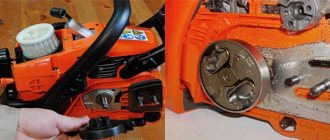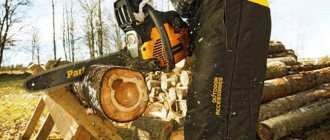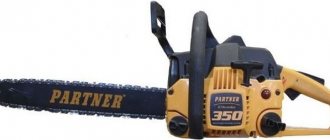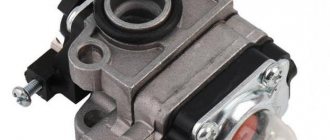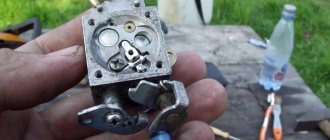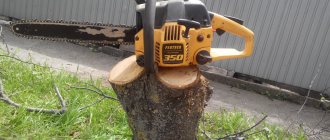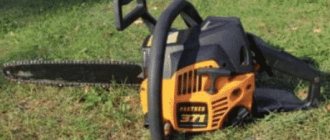Diagnostics of chainsaw Partner 350
Correct identification of a malfunction is already more than half of the repair. In case of malfunctions related to the fact that the saw does not start, the essence of the diagnosis is to check the spark and the presence of fuel in the cylinder, since in the chainsaw there is either nothing to burn or nothing to set on fire.
Spark test
To check the spark, you need to unscrew the spark plug, install it in the cap of the high-voltage wire and attach it to the cylinder (there should be ground on the spark plug). Next, pull the starter several times, while carefully looking at the spark plug. There will be no spark if the Partner 350 chainsaw has faults such as:
- defective spark plug (can only be eliminated by replacing it with a known good one);
- broken wires in the system;
- malfunction of the ignition control button;
- defective ignition coil;
- no gap between the coil and the flywheel;
- broken key between the crankshaft and the flywheel.
Checking the fuel
The first sign that the cylinder is not getting fuel is a dry spark plug. Having discovered a dry spark plug, the next thing you need to do to more accurately determine the malfunction is to try to run the Partner 350 chainsaw by pouring no more than 5 ml of gasoline into the cylinder, through the spark plug hole. If the chainsaw does not start after this, then most likely there is no compression in it or there is not enough compression to start the engine. Causes:
- CPG wear;
- thermal seizure of the cylinder or piston;
- scuffing due to foreign body entering the CPG.
If, after pouring gasoline under the spark plug, the saw starts, then the problem is in the carburetor or fuel line of the Partner 350. It is necessary to carry out a complete diagnosis of the fuel system.
Bearing diagnostics
When diagnosing a chainsaw, it is necessary to check the crankshaft bearings for play. To do this, you need to shake the flywheel up and down. If there is play, the bearings must be replaced.
Also be sure to check the crankshaft connecting rod play. To do this, you need to lock the piston in the upper position and gradually shake the flywheel from left to right, simulating its natural movement. If there is play, then the Partner 350 crankshaft must be replaced.
How to start a chainsaw
The effectiveness of any tool directly depends on compliance with the rules of its use. First of all, this concerns the launch. This should be done in the following sequence:
- Apply the chain brake by pressing it forward.
- Remove the protective cover from the tire, if equipped.
- Turn on the decompression valve, which will make the starting process easier.
- Press the fuel choke. This is necessary to reduce the number of swaps.
- Set the combination lever to the idle start mode all the way down, having previously locked the gas lever.
- Place the tool on a flat surface, grasp the chainsaw with both hands so that the cutting part is located at a distance from this surface. In this case, place your left hand on the handle, and your right hand near the starting cable. The tool needs to be secured with your foot, for which you can simply step on the back handle.
- Now the starting rope must first be pulled tight and then pulled several times. In this case, you need to move upward from the body.
- As a result of a short start, the engine will stall. Therefore, after this, the combination lever must be moved up one click, and then started again.
- If the engine is running, the throttle lever must be pressed and the combined engine must be switched to idle mode.
- Now the chain brake needs to be removed and you can start using the tool.
Despite the simplicity of the process, situations may arise when the chain saw still does not start. The reasons are not always related to tool failure. Perhaps not enough force was applied. If, after several attempts, the startup is unsuccessful, it is worth conducting a thorough inspection of the device.
Device
The general arrangement is made in a traditional style. It is characterized by simplicity, which means high reliability of the device.
The diagram of the general structure of the Partner 350 chainsaw clearly confirms this.
Starting the engine is simple and reliable. This was made possible thanks to the presence of electronic ignition. The primer (fuel priming pump) plays an important role during startup.
The air filter is equipped with a double air purification system. Due to the starter drum being equipped with an impeller, large debris particles do not enter the filter at all. This increases its service life and increases the degree of air purification. Overall, this has a positive effect on engine performance.
Safe handling of the working saw is achieved by the presence of a chain brake operating in two modes. Manual and automatic.
The oil pump only turns on while sawing. This means that the chain lubrication system is in automatic mode. Keep in mind that different types of oils are used to lubricate the chain and prepare the working mixture. Find out what oil is used to burn the Partner 350 chainsaw
They sawed the chains. The Partner 350 saw is equipped with an Oregon 91P052E 3/8″ 1.3mm 52 chainsaw. Valid replacements: Stihl 39970000052s and others. For example, Husqvarna 5776151-22. With a 3/8″ chain pitch and 1.3mm groove width, ensure that the link count does not exceed 52. Anything less (46-50) may not be desirable.
The anti-vibration system on the Partner 350 is a bit harsh. Due to the fact that this saw is not intended for professional use, the system as a whole can be considered satisfactory. By the way, the following models have made significant improvements in this regard.
Specifications
| Type | petrol chain saw |
| Class | hobby |
| Cylinder volume (cm 3) | 40 |
| Engine power (kW/hp/rpm) | 1,5/2/9000 |
| Fuel tank volume (l) | 0,25 |
| Fuel consumption, tank 0.25 l (min) | 40-50 |
| Oil tank capacity (l) | 0,15 |
| Oil consumption, tank 0.15 l (min) | 40-50 |
| Recommended tire length (cm/inch) | 35.56-40.64 cm/14"-16" |
| Tire included (cm/inch) | 40/16 |
| Chain pitch (inch/mm) | 3/8″/9,52 |
| Adjusting chain tension | instrumental, frontal |
| Carburetor | Walbro & Ruixing |
| Ignition system | Zhejiang Fenglong, CDI |
| Oil pump type | auto |
| Oil pump flow (9000 rpm, ml/min) | 8-15 |
| Idle speed (rpm) | 3 000 |
| Maximum speed (rpm) | 13 000 |
| Chain speed at maximum power (m/s) | 22,8 |
| Handle vibration level (front/rear) | 15/15 |
| Noise level near the operator's ear (dB) | 103 |
| Noise level measured (dB) | 108,7 |
| Noise level guaranteed (dB) | 108 |
| Spark plug | NGK CMR7H |
| Interelectrode gap (mm) | 0,6 |
| Cylinder diameter (mm) | 39,53 |
| Piston stroke (mm) | 31,1 |
| Drive Link Thickness (in/mm) | 0,05/1,3 |
| Drive sprocket type/number of teeth | 3/8: Spur/6 |
| Weight (without tire and chain, kg) | 4,8 |
| Manufacturer | Partner |
| Manufacturer country | China |
| Guarantee | 2 years |
Tools
In order to disassemble Partner 350 you will need several specific tools:
- Clutch wrench (you can buy it or make it yourself from a socket of a suitable size).
- Piston stopper.
- Torx hex set.
- Soft metal drift.
Special key for clutch
Punch
For ease of disassembly, Partner 350 will need tweezers and a medical clamp. As for ordinary tools, you need to have screwdrivers or a cordless drill with a set of attachments, and a hammer.
Algorithm and description of the disassembly process
If you need to completely disassemble the Partner 350 chainsaw, the first thing to do when disassembling is to clean the saw using a compressor. Next, the chainsaw components are removed in the following order:
- chain brake cover and saw set;
- top cover;
- saw handle;
- starter.
After the first stage of disassembly is completed, we clean the chainsaw again using a compressor, since we already have access to the air ducts, which in most cases are heavily contaminated with wood dust.
At the next stage, it is convenient to remove the air filter housing and the Partner 350 carburetor.
After removing the carburetor, the inlet window of the cylinder must be plugged with a rag, this will prevent foreign objects from entering the engine crankcase.
The muffler can be removed either immediately after the carburetor is removed, or after the engine is removed. The outlet window is also covered with rags.
Next, remove the clutch and flywheel.
To do this, you will need to use a piston stopper by installing it in the spark plug hole.
The clutch on all Partner 350 chainsaws unscrews as the chain moves, this is done so that it does not unwind during operation. The flywheel nut has a standard thread and is unscrewed using a 13mm socket, counterclockwise.
After removing the clutch, the oil pump becomes accessible; it must also be removed.
The last step is to unscrew the engine screws and remove it from the housing.
Instructions for removing the flywheel from the crankshaft
To remove the flywheel, you will need to use a special puller, but most craftsmen use a drift made of soft metal, since with its help the removal process is significantly accelerated.
The bottom line is that the flywheel nut is unscrewed until it is level with the plane of the shaft, after which, using a hammer and a drift mounted on the nut, with one sharp blow, the flywheel is removed from the shaft.
The method is a little barbaric, but time-tested and recommended by many masters as the most practical and reliable.
Engine
In most cases, the following problems occur in engine operation:
- the engine stopped starting;
- the engine starts, but after a while it stalls;
- the engine is not able to develop the required power;
- The engine is extremely unstable.
How to check crankshaft seals
The presence of oil seal leaks can only be checked by getting to the crankshaft itself and carefully examining it for leaks. You can see how to do this correctly in the video:
How to check compression on a chainsaw
At a compression level below 8 atmospheres, the engine will not have enough power, which means the chainsaw will not be able to fully function.
To measure compression you need:
- Remove the protective cover and unscrew the spark plug.
- Insert the tip of the compression gauge into the hole where the spark plug should be located.
- Using the starting cord, rotate the piston and remember the maximum readings of the measuring device.
How to properly install a piston on a chainsaw
The work of replacing the piston for most models of modern chainsaws is carried out according to the following algorithm:
- The top and side covers are removed.
- The candle is unscrewed.
- The stoppers are removed from the shock absorbers and the handle is disconnected from the body.
- The drive sprocket and starter are removed.
- A piston stopper is installed in the spark plug hole and the nut securing the flywheel and clutch is unscrewed.
- The flywheel, clutch, and worm drive of the oil pump, located immediately behind the clutch mechanism, are removed.
- The screws securing the carburetor and air filter are unscrewed, after which these components are removed along with the engine control lever.
- The ignition coil is removed, as well as the muffler.
- The saw is turned upside down and, by unscrewing the screws securing it to the body, the engine is disconnected.
- The pan is unscrewed and the piston is removed.
- Since the piston is removed only together with the crankshaft, to disconnect it it is necessary to remove the retaining rings.
- The old piston is replaced with a new one, but as carefully as possible. This is caused by the high fragility of compression rings.
- The crankcase is put in place, and sealant is used instead of a gasket.
All subsequent actions are carried out according to the reverse algorithm of disassembly.
Design features of the Partner 350 chainsaw
A reliable and convenient saw when using this model is a 1300 W gasoline engine. It is characterized by easy starting, which is carried out thanks to the built-in professional fuel pump and electronic ignition system.
The chainsaw is equipped with a safety system that automatically activates a double inertia chain brake. The chain is also automatically lubricated. Changing the chain tension of this device is very simple using two keys.
The chainsaw is equipped with a fuel primer, so it is easy to start at any time of the year. The starter drum of the tool is equipped with a special impeller, with the help of which it is cleaned of contaminants.
A filter with CCS is capable of capturing all residual particles. In addition, this system allows you to use the air filter for a long time, saving fuel consumption.
Manufacturers of the Partner 350 chainsaw equipped the cylinder walls of the piston group with a chrome coating, which significantly increases the service life of the tool.
Assembly Partner 350
In order to correctly assemble Partner 350, it is necessary to install all elements in the reverse order of removal.
If this is your first time repairing a Partner 350 chainsaw, then when disassembling, place the parts in the order in which they were removed. This will prevent you from getting confused and forgetting to install any node.
An important feature of the Partner 350 chainsaw engine assembly is that the crankcase cover is installed without a gasket. Instead, a red sealant is used, which is applied in a thin layer to the crankcase installation site. Before applying the sealant, it is necessary to degrease the crankcase cover and its installation location for better adhesion of the sealant.
Setting the flywheel and coil clearance (ignition adjustment)
During the assembly process of the Partner 350 chainsaw, if not only the flywheel, but also the ignition coil was removed, a gap must be set between them. To do this, first install the flywheel, then place a piece of a one and a half liter plastic bottle on it, and then place the coil and fix it with two fastening screws, while the flywheel must be turned toward the coil with magnetic contacts.
After adjusting the clearance, rotate the flywheel. If it does not touch the coil contacts, then the gap is set correctly.
Common Partner saw breakdowns: diagnostics at home
The Partner gasoline saw cannot be called unreliable. For many users it works without problems in winter and summer, for many years. But others complain about the same typical problems:
- The chainsaw won't start.
- The chainsaw starts but stalls.
- Fuel does not enter the cylinder.
All these problems have internal causes in the parts and components of the tool. This means that in order to get to the bottom of it and fix the breakdown, you will have to disassemble the electric saw. This is not as difficult as it may seem, because manufacturers always take this possibility into account.
To independently diagnose problems at home, you need to understand that common chainsaw problems in the vast majority of cases are caused by the same reasons. Therefore, just by the symptoms, you can guess where the source of the problem is.
For example, if a chainsaw does not start , then the reason most likely lies in the ignition system, namely the spark plug. If air leaks into the cylinder, then you need to look for a defect in the fuel system. A dirty filter causes the engine to stall and smoke, and so on. Let's look at these cases in detail so that you feel confident when repairing the Partner chainsaw yourself.
User guide
The instructions contain recommendations according to which the owner of the Partner 350 chainsaw will not have problems when handling it. Safety measures and rules for using the product during operation are described in detail. Issues of repair, maintenance and care of the Partner 350 chainsaw are discussed.
Types of chainsaw repairs permitted independently are determined by the instructions. All other faults are repaired in a specialized workshop.
The instruction manual should always be at hand, especially if this is your first chainsaw and you just bought it. First of all, be sure to read it and seek help if you have any questions while using the tool. Download and print the Partner 350 Chainsaw manual below.
Replacing the piston group
If it is necessary to replace the cylinder and piston of the Partner 350 chainsaw, it must be disassembled according to the algorithm described above. The piston is secured at the top of the crankshaft connecting rod using a piston pin. A separator with roller bearings is installed between the pin and the connecting rod.
To replace the piston and cylinder, it is necessary to remove the piston from the cylinder and remove it from the crankshaft; to do this, remove the piston pin stopper from one side of the piston using pliers and a small screwdriver.
Then it is squeezed out from the opposite side using a small screwdriver. If the pin comes out tightly, you can slowly knock it out using a hammer and a drift, suitable in size, but smaller than the diameter of the piston pin mounting hole.
The new piston is installed on the crankshaft so that the arrow on the piston cap points in the direction of chain movement.
To check the correct installation, you need to take the crankshaft with the piston installed on it so that the shaft on which the flywheel is installed is in your left hand, with the arrow facing away from you.
After the new piston is mounted on the crankshaft, a ring is installed on it, after which the piston is inserted into the cylinder, while the parts should be lubricated with engine oil, which will prevent the ring from breaking and make the process easier. Next, the crankcase is installed.
Service center technicians use an algorithm for replacing the piston group, which allows the work to be done without completely disassembling the Partner 350 chainsaw. How such a replacement occurs can be seen in the video.
Repairing the fuel system of a chainsaw
When the fuel supply is interrupted, it is not surprising that the chainsaw does not work. Moreover, in this case there is only one problem: no fuel enters the cylinder. And there may be several reasons for this problem, and you have to find that very reason.
First, try disconnecting the fuel hose and observing the fuel pressure. A weak, intermittent flow indicates a clogged filter. Take it out, rinse and dry it, and if possible, replace it with a new filter. Also clear the breather (valve) of any blockages.
Check the condition of the carburetor filter and, if necessary, rinse it thoroughly, dry it and reinstall it. We described in detail about setting up the carburetor above, and these actions in this case will also not be superfluous.
If the reason is not in the breather or in the carburetor, then everything may turn out to be trivial. Make sure there is enough fuel in the tank.
There may also be problems with the cylinder-piston group (abbreviated CPG) of the Partner chainsaw. This failure can be considered serious because the cylinder and piston are the basis of the engine. Therefore, the CPG is an expensive component, the cost of which reaches half the cost of the entire tool.
The power of a chainsaw directly depends on the coordinated operation of the cylinder and piston. During operation, especially if operating rules are not followed, the cylinder, piston and rings may wear out. In this case, only replacing parts will help.
CPG parts may be damaged mechanically. These defects can be diagnosed independently. Remove the muffler. You can see the CPG in the hole. Scratches and scuffs on the surface of the cylinder, located randomly, occur when debris, fragments, or solid foreign particles enter.
If the cylinder is darkened, and this defect is observed over its entire surface, then, in all likelihood, you filled the chainsaw with low-quality fuel. Bad gasoline also affects oil scraper rings. A worn surface of the cylinder on the muffler side is a sign of critical overheating of the chainsaw during operation. Minor mechanical damage can be corrected by replacing bearings, rings, etc. But in case of deep scuffing, the CPG will have to be completely replaced by contacting a partner chainsaw repair shop.
Where is the breather located
The Partner 350 chainsaw, like other chainsaws, has two breathers. One is responsible for equalizing the pressure in the oil tank, the second - in the fuel tank. The oil tank breather is installed next to its cover, and a special disposable metal plug is installed on top of the breather to allow air to pass through.
The fuel tank breather Partner 350 is located in the area where the carburetor is installed, like the previous one, it is closed with a plug.
Tip: Breathers must be replaced when a vacuum is created in the tanks and the supply of fuel and oil stops.
Where it is located?
The breather on the Husqvarna chainsaw, as in models from different manufacturers, is located in the tank. Sometimes it becomes clogged, which leads to problems with starting the tool or the chainsaw runs intermittently or does not start.
How to fix the problem? Here are several options:
- use a compressor for cleaning;
- Clean the small breather hole with a needle.
In both cases you have to get to this detail. Taking into account the structural features of chainsaws, in order to clean the breather, you will have to remove the handle of the device.
Problem: chainsaw stalls after starting
A common situation : the Partner chainsaw stalls at high speeds, although before that it starts and runs without problems at medium gas. Sometimes at medium it also works intermittently - but at full throttle it immediately stalls. This problem is faced by many users who save on quality fuel.
Low-quality gasoline easily contaminates parts with soot. In this case, checking the filters (air and fuel) will not hurt. Moreover, the muffler suffers from poor fuel and the carbon deposits it creates.
The combustion products of dirty fuel simply clog it, forming an impenetrable plug of soot. This plug greatly reduces engine power. In this case, gasoline is consumed in large quantities, but there is no result in power. Check and clean the muffler:
- Remove any remaining fuel from the tank.
- Remove the muffler and take it apart.
- Do not leave the outlet open; cover it with a napkin or lid.
- Clean all carbon deposits from the muffler using a cable and/or detergent. According to reviews, “Mr. Muscle” for pipes or similar household chemicals has proven itself well.
- A clean muffler needs to be dried. To speed up the process, you can do this with a hair dryer.
Oil pump repair and drive sprocket replacement
Repair of the oil pump on the Partner 350 chainsaw is necessary if the oil supply has completely or partially stopped. The oil pump mechanism includes the pump itself and a gear with a worm gear, which is driven by a sprocket connected to the clutch.
The most common problem with an oil pump is missing threads and splines on the gear or splines on the worm gear. The situation can be corrected by replacing the parts with new ones.
To remove the oil pump on the Partner 350, you need to remove the side cover and the chainsaw tire, then lock the piston and use a special wrench or a homemade wrench from the 24mm socket to unscrew the clutch.
The clutch has a high tension torque, so you need to use a wrench and turn it strictly clockwise. Do not try to unscrew the clutch with a hammer and chisel, this often leads to breakdown of the mechanism and also has a bad effect on the condition of the crankshaft bearings.
To replace the Partner 350 drive sprocket, you simply need to unscrew the clutch, remove the old part and install a new one. The sprocket is mounted on the shaft through a needle bearing. When replacing the sprocket, it must be checked for defects and lubricated. For lubrication, you can use regular Litol or any other that can withstand high speeds.
The process of replacing the drive sprocket is shown in the video, after watching which you can easily repeat what you saw on your chainsaw.
Troubleshooting common problems
The Partner 350 has popular faults that owners of these saws can diagnose and fix themselves. Let's take a closer look at popular faults and how to repair them yourself.
Stalls when you press the gas
If the Partner 350 stalls when you press the gas, then most likely there is a problem with the fuel system. The most common breakdown is an incorrectly adjusted carburetor or its malfunction, as well as extraneous air leaks.
Tip: If the chainsaw stalls when the speed increases, you should not immediately adjust the carburetor. Start by checking the engine for foreign air leaks. One of the signs of air leaks is increased idle speed.
Starts and stalls
If the Partner 350 starts up and immediately stalls, then, as in the previous case, there may be several reasons, but the most common is a difficult fuel supply. You should start troubleshooting by checking the condition of the fuel filter and lines. If the fuel flows normally, then check the spark and try to start the chainsaw on a new spark plug, as the saw may stall due to interruptions in sparking.
It is also necessary to check the draft of the air damper. If it does not open the air damper or does not open it completely, the engine may stall due to excessive fuel enrichment.
Lack of chain lubrication
There are several reasons for the lack of lubrication supply on the Partner 350 chainsaw, and in this case we can list them all.
- Oil line rupture.
- Oil filter clogged.
- Defective worm drive gears.
- Line or pump clogged.
How to solve oil pump problems is described above.
Pouring a candle
A very common problem that owners of Partner 350 have to face. The first place to start checking is to replace the spark plug with a known good one. If it doesn’t help, the spark is good, but the engine floods, then the reason is hidden in the carburetor settings. Instructions for diagnosing and adjusting the carburetor for the Partner 350 are on our website.
There is little oil in the fuel mixture
First, let's look at the most unpleasant case. Why? Because before manipulating the filters, it is better to make sure that the oil and gasoline are mixed in the correct ratio.
Here, however, it is worth noting that if you have already started your saw many times (for example, ten times), but continues to start, and then stall again when the speed increases, then apparently everything is in order with the fuel. Otherwise, it would simply stop starting altogether.
But still, I recommend immediately dispelling the slightest doubt about the quality of the fuel as soon as your saw stalls when picking up speed for the first time. Because if the reason is fuel, then, as mentioned above, you can end up with expensive repairs. And so, everything can still work out. To dispel doubts is to drain the old fuel from the tank and fill it with freshly prepared fuel, in which oil and gasoline are mixed in the correct proportions.
It is better to look at the instructions for the saw for the correct ratio. If you have lost it, then look at the ratio on the oil package. Usually it is 1:50 or 1:40. If the oil used is “non-native” (well, for example, for Stihl chainsaws there will be little Stihl “native”), then I recommend using a proportion of 1:40, even if the oil package says 1:50.
For accurate dosage, I personally use a medical syringe and a measuring container in which one liter of gasoline can be clearly measured. I pour a liter of gasoline into a container, fill a syringe with 25 (at 1:40) or 20 (at 1:50) cubes of oil and add it to the gasoline.
After preparing a new mixture, we drain the previous mixture from the tank, which we are unsure of, and fill it with fresh, just prepared one.
Now that you have done everything to dispel any doubts about the quality of the fuel, let's move on to further actions.
As I wrote above, if there is a lack of oil, scuffing can form on the piston and cylinder walls - and they almost always do. If you are lucky and no scuffs have appeared, then with a new fuel mixture prepared in the correct ratio, the chainsaw should start working normally.
If scuffs appear, the saw may start and stall several more times, after which it will stop starting altogether. In this situation, I sympathize with you, since, most likely, now you will need to replace the piston group, which will be very expensive.
If the saw, as before, starts and stalls at high speeds, then we manipulate the filters.
Video: Assembling the Partner 350 Chainsaw
The condition of all elements of this group can only be fully assessed visually through the hole from the removed muffler. If possible, remove the cylinder head or the entire cylinder.
If the cause of the chainsaw breakdown is minor, it does not matter. The instrument is made by Russian or Chinese manufacturers. Disassembling and repairing the device can be done quite easily by yourself after studying the design instructions and troubleshooting videos.
Source
The Partner 350 chainsaw is a “relative” of the famous Husqvarna brand, since Partner is a subsidiary of Husqvarna. Lightweight and convenient, reliable and simple, Partner 350 is widely used in cottages and private homes. Pruning branches, branches, cutting down trees. This is not a complete list of jobs that can be done easily and effortlessly with a saw. A brief overview will help you get to know this in more detail.


